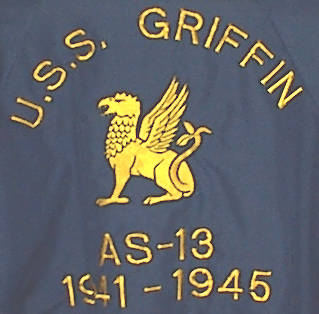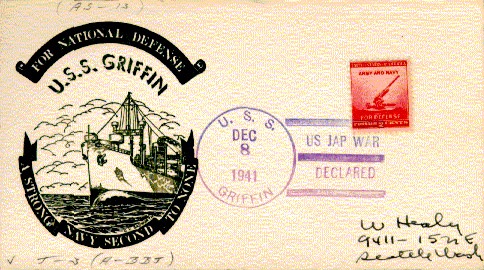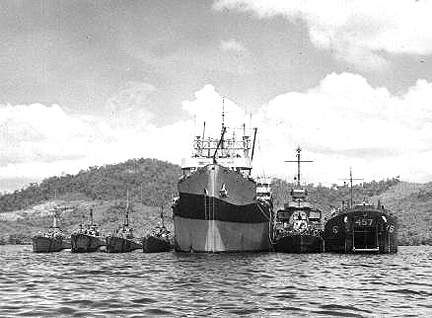 |
United States Navy
|
Submarine Tenders
|
USS Griffin AS 13
|
 |
| USS Griffin AS 13 in 1943 |
|
 |
Displacement
(tons Laden) |
14,000 |
 |
Built / Launched |
? / 1939 |
| Length |
492' 0" |
|
Built By |
Sun Shipbuilding & Dry Dock.,
Chester, Pa. |
| Beam |
71' 0" |
|
Class |
Griffin |
| Draft |
25' 10" |
|
Commisioned |
1941 |
| Speed (rated) |
17.0kts |
|
Decommisioned |
1945 |
| Compliment |
911 |
|
Dispositon |
Sold |
Go directly to Griffin's Page 2 |
If Griffin HAD a jacket patch- it would have been
like this - not that "fake" you see on ebay. This IS
a picture of Griffin crewman Henry G. Spenceley's jacket. |
|
|
| Named for Rear Admiral Robert Stanislaus Griffin, who served with distinction from 1857 through 1921. By 1913 he had become the Engineer in Chief and head of the Bureau of Steam Engineering. He is particularly noted for his outstanding work in engineering, in particular conversion of captured German ships during World War I - work for which the President awarded him the Distinghished Service Medal.
With war looming, and the decision made to build up the United States Naval forces - the Vinson-Walsh Act (the "Two Ocean Navy" Act) of July 19, 1940 was passed which provided for increasing the size of the fleet by 70%. Recoginzed as essential for servicing such a fleet - auxiliary vessels were also provided for in that program. Along with many new construction ships - in order to get some ships to the fleet as soon as posible - existing merchantmen were acquired and converted for specific tasks. One such ship was Mormacpenn, a Maritime Commission C-3 type pre-war cargo ship, which was built by Sun Shipbuilding & Dry Dock., Chester, Pa. and launched 11 October 1939. She served briefly with Moore-McCormack, Inc., and then acquired by the Navy in 1940, renamed Griffin (AS13). Her conversion to a submarine tender was accomplished by Robbins Dry Dock & Repair Co., Brooklyn, N.Y.
Griffin was commissioned 31 July 1941, Comdr. S. D. Jupp in command. Conversion and outfitting was completed in September 1941, after which Griffin conducted shakedown off the East Coast.
In late 1941 Admiral Doenitz increased the efforts of his U-boats against Allied Convoys bound for Britain, whereupon Admiral King ordered Richard Edwards (COMSUBLANT) and Ralph Christie (COMSUBRON FIVE) to respond. Edwards and Christie boarded GRIFFIN and sailed 22 November 1941 for Argentia, Newfoundland escorting several S-boats* and USS Mackerel. . There less than a month - they saw little action.
*[Ed. Note: The true purpose of Edwards / Christie / GRIFFIN's mission had to be kept secret for two reasons: the first, this was before the United States formally entered the War - and was still proclaiming it's neutrality. Second - the United States did not want the fact that submarine deployments had already been planned for as part the mobilization committed to under the secret "Anglo-American" agreements should the United States enter the war. Because of this secrecy - this deployment is not well documented, leading to disagreement between sources about how many boats - and which ones. For instance - the DANFS only mentions the deployment in three S-boat entries (S-33, S43 and S-47) - and that "mention" only refers to the deployment as "research to see how the S-boats would do in high-latitude arctic and subarctic conditions". While such research may indeed been undertaken - it's known that the true purpose of the deployment was to counter the increase in German submarine aggression in the area; and it appears the "research" cover story was invented to explain the deployment. This also leads to speculation of why Mackerel was included (other than Christie was scraping the bottom of his "barrell" for boats - since most were in the Panama area or overhaul in the yards); Mackerel was a research / training submarine, not intended for combat - and was assigned to Subron One (New London) rather than Christie's Subron Five. Some sources note that GRIFFIN sailed (in addition to Mackerel) with five S-boats; while other sources note six S-boats. S-30's historical record complied by the Navy after World War II also notes a patrol in the Newfoundland area (Division of Naval History, Ship Histories Section, Navy Dept. History of S-30 compiled 17 February 1954 quoting from S-30's log). As the four boats S-30 - S-33 usually sailed together - (Having just completed a patrol off New England in August, 1941 - and then undergoing a yard period at Philadelphia) that would indeed make six S-boats plus MACKEREL for a total of seven as reported in several sources. The question remains to be researched further and varified.]
 |
| Envelope cancelled aboard Griffin on the day after Pearl Harbor |
Re-called to Newport, R.I., after Pearl Harbor, Griffin's mission suddenly became getting re-inforcements to the Southwest Pacific, so she departed 14 February for Pananma. Captain Christie was tasked with taking S-class boats to the Southwest Pacific; he originally intended to take approximately 18 boats from Squadron Five - but after determining that the boats in Division 51 (S 20, S21, etc.) weren't up to facing combat, decided to leave them at the Panama Canal. Then just before departing - Admiral King assigned the boats from Division 52 (S 30, S31, etc.) to Alaskan defense leaving just six boats of Division 53 (S 42, S 43, S 44, S 45, S 46 and S 47) to depart on 5 March 1942 for Australia. Griffin was loaded with Mark XIV torpedoes for the Fremantle Submarines, RADAR for surface ships, and tons of spare parts and Mark X torpedoes for her own S-boats. Accompanied by two destroyers - the convoy made good an average 9 1/2 knots an hour. One stop was made for fuel at Bora Bora in the Society Islands. Griffin arrived Brisbane 15 April 1942 with it's Division 52 boats. With the arrival of five additional S-boats from Manila via Java and Fremantle; Subron Five was now at eleven boats. Along with tending her brood (and the occasional surface ship) GRIFFIN started building a submarine base at at New Farm Wharf - which would, in time, become one of the largest and most elaborate submarine facilities in the world. The old S-boats made many patrols - inflicting damage to the Japanesse Fleet when they could; however after a year it was becoming painfully obvious that the limitations of the now nearly 20 year old S-boats' capacity in firepower, duration (fuel, etc.) was not doing as effective a job at countering the Japanese as needed. The boats simply weren't designed for the distances that is the theater of the Pacific. It was decided to send the S-boats home for repairs and then deploy them in defensive patrols where they could be much more effective. Squadron Two with Tender HOLLAND was ordered to relieve Squadron Five including tender GRIFFIN. The tender departed Brisbane for the Fiji Islands 11 November; and 1 December sailed to Bora Bora to escort Submarine Division 53 to the Canal Zone. Arriving Balboa 7 January 1943, GRIFFIN continued north to Oakland, Calif., arriving 20 January.
|
 |
After repairs at San Diego, Griffin again departed for the Pacific, sailing 27 April 1943. She arrived Pearl Harbor 4 May to take up her vital support duties, and remained until 3 January 1944. The ship performed refits, battle repairs, and general upkeep on submarines before sailing to Mare Island to arrive 10 January. Griffin returned to Pearl Harbor 17 March, and departed 8 April for the great submarine base at Fremantle, Australia. She arrived 8 May and Immediately set about servicing the growing submarine fleet. The tender remained at Fremantle until 20 November 1944, during her stay founding a rubber fabrication shop which solved one of the great shortages on board the submarines. She then moved closer to the Japanese shipping lanes at Mios Woendi, New Guinea, arriving 9 December. There she tended submarines, surface craft of all kinds, and even lent her repair equipment to shore facilities.
Griffin remained at Mios Woendi until 1 February 1945 when she sailed for Subic Bay, via Leyte. Arriving 10 February, Griffin set up one of the initial submarine repair facilities in the Philippines since 1942. She also helped to salvage damaged destroyer LaValette. Shifting base, the tender sailed 22 March via Leyte, and arrived in the Hawaiian Islands 10 April. After a brief stay at Pearl she departed 10 May for Midway, arrived 4 days later, and set up another repair facility for submarines. By that time submarines supported by Griffin had practically annihilated Japanese merchant shipping and had played a decisive role in the great Pacific offensive.
She remained at Midway until 10 September, then sailed to Pearl Harbor and San Francisco, entering the bay 24 September. Decommissioned at Mare Island 12 October 1945, the ship was placed in reserve. Later she transferred to the Stockton group, Pacific Reserve Fleet, where she remains in reserve, in service, tending reserve submarines through 1967. |
The USS Griffin - with four subs to starboard - and the heavily damaged LaValette to port (Also the USS 457). Here is the report take from the divers just after having completed recovery of the killed sailors - and applying a patch to the LaValette's side:
The following statement is by Hugh Loveall who was one of the divers, all the divers were awarded the Navy and Marine Corps Medal.
"We went into the ship through the hole blown in the side of the ship. Because of water tight integrity we could not open any of the hatches. I went in first and brought the first three bodies out. They had been in the water long enough that the first ones I found were floating against the top of the compartment. We would tie a line around them and the crew on top would pull them out. After the bodies were recovered we then put a plate over the hole in the side, using high velocity tools shot bolts into it and into the sides of the LaValette. We worked 16 hours straight so the water pumps could keep enough water out that it could get underway back to Pearl Harbor. The LaVelette hit a mine while on patrol off Corregedor".
At this time the Griffin was caring for four submarines and along side of the destroyer was the USS 457 the writer is not sure of the reason that this vessel was tied up with us also. After we reestablished a new sub. base there we went to Pearl and then to Midway for the same purpose. What a lovely place to end a war in.
(picture and written record courtesy Henry G. Spenceley)
|
|
| History from the Dictionary of American Fighting Ships. |
|
Here is the Griffin's War Time Movements during 1944-1945 -
this will give you an idea just how mobile these Tenders were during World War II: |
| Departed |
Pearl Harbor, T.H. |
Jan. 3, 1944 |
| Arrived |
Mare Island, Calif., For Refit. |
Jan. 10, 1944 |
| Departed |
Mare Island |
Mar. 9, 1944 |
| Arrived |
Pearl Harbor |
Mar. 16, 1944 |
| Departed |
Pearl Harbor |
Apr. 8, 1944 |
| Arrived |
Brisbane, Australia |
Apr. 22, 1944 |
| Departed |
Brisbane |
Apr. 27, 1944 |
| Arrived |
Freemantle, Western Australia |
May 7, 1944 |
| Departed |
Freemantle |
Nov. 20, 1944 |
| Arrived |
Brisbane |
Nov. 29, 1944 |
| Departed |
Brisbane |
Dec. 1, 1944 |
| Arrived |
Mios Woendi, New Guinea |
Dec. 8, 1944 |
| Departed |
Mios Woendi |
Feb. 1, 1945 |
| Arrived |
Talcoban, Leyte, Philippine Is., |
Feb. 4, 1945 |
| Departed |
Talcoban |
Feb. 8, 1945 |
| Arrived |
Olongopo, Subic Bay |
Feb. 10, 1945 |
| Departed |
Olongopo |
Mar. 22, 1945 |
| Arrived |
Talcoban |
Mar. 25, 1945 |
| Departed |
Talcoban |
Mar. 26, 1945 |
| Arrived |
Pearl Harbor |
Apr. 10, 1945 |
| Departed |
Pearl Harbor |
May 10, 1945 |
| Arrived |
Midway Island |
May 14, 1945 |
| Departed |
Midway Island |
Sep. 10, 1945 |
| Arrived |
Pearl Harbor |
Sep. 14, 1945 |
| Departed |
Pearl Harbor |
Sep. 17, 1945 |
| Arrived |
San Francisco, U.S.A. |
Sep. 24, 1945 |
Documentation courtesy Henry G. Spenceley
Go to Griffin's Page 2
AS 14 USS Pelias
|
 |
| Table of Ships |
 |
| Go to TenderTale Main Page |
 |
| © 1997, 2006 Common Cents Computers |



